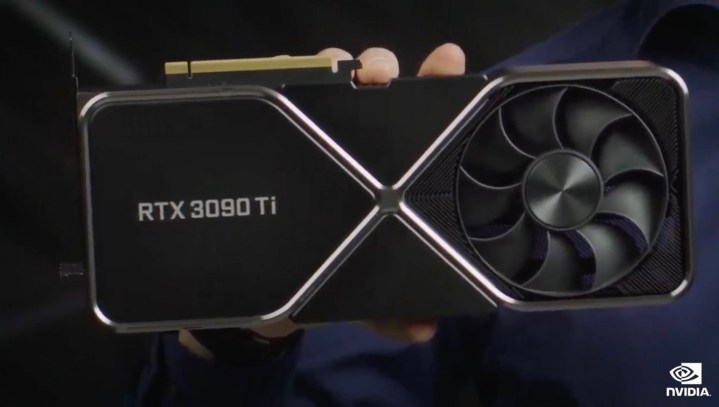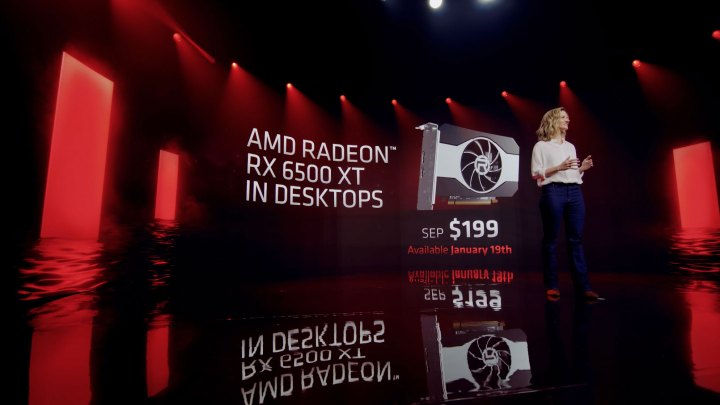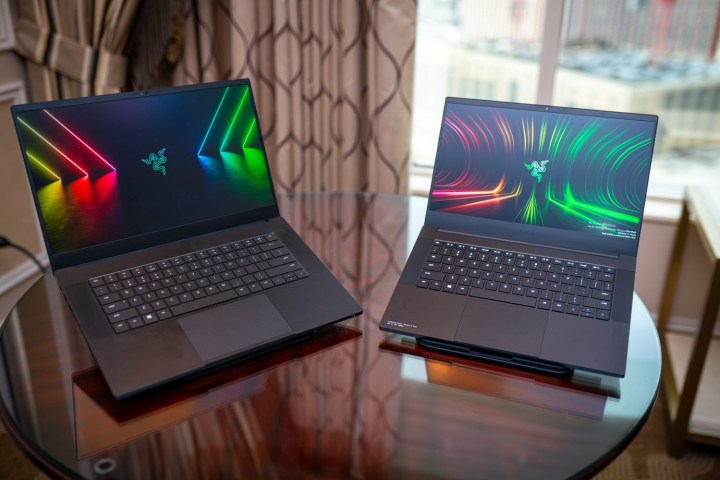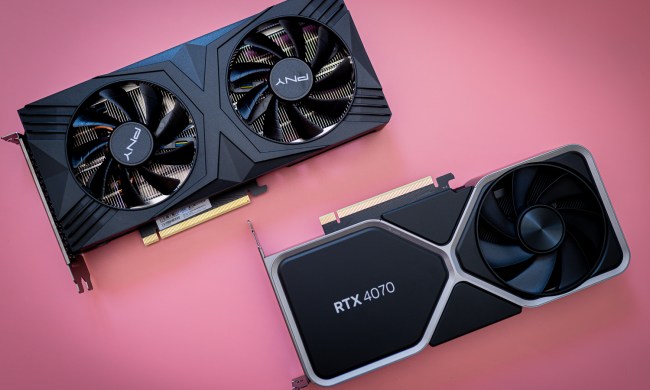CES 2022 wasn’t focused on graphics cards, but AMD and Nvidia still came out in full force with announcements. We have new desktop graphics cards arriving within the month, new mobile GPUs that are already in laptops, and graphics options for gamers that don’t want to lug around a massive gaming machine.
I’ll run you through all of the biggest announcements from AMD and Nvidia, as well as which company I think made a better showing at CES this year. If you want all of the gritty details, make sure to pull up our roundups of everything Nvidia announced at CES and everything AMD announced at CES.
The RTX 3090 Ti and RX 6500

CES doesn’t normally bring new generations of graphics cards from AMD and Nvidia, and this year was no different. While we’re eagerly awaiting the release of RTX 40-series and RX 7000 GPUs, AMD and Nvidia took CES to fill out their existing graphics card ranges.
AMD only announced one new graphics card: The RX 6500 XT. It’s not too exciting, targeting 1080p with high settings, but the price perked up my ears. It’s only $199, which is great in a time when I was sure GPUs under $200 were all but dead. Of course, it won’t sell for $200 given the GPU shortage, but it should offer a good alternative to cards like the GTX 1650 and RX 570 that have become way too expensive over the past year. It’s coming out on January 19.

Nvidia announced two graphics cards: The RTX 3050 and RTX 3090 Ti. I’m excited about the RTX 3050, especially given the GPU pricing crisis. It’s launching for $249 on January 27, and it fills in the lower end of Nvidia’s RTX 30-series range. We never got a desktop RTX 2050, so I assumed this class of GPU was dead to Nvidia.
Clearly, it’s not. Like the RX 6500 XT, the RTX 3050 is offering an alternative to budget cards from years ago that have become too expensive. It can even run games like Guardians of the Galaxy and Control with ray tracing turned on, according to Nvidia, which is fantastic for a graphics card at this price.

The RTX 3090 Ti could not be further from that. What is this, and why is it here? The RTX 3090 is already an obscenely powerful graphics card, and Nvidia’s big reveal just doesn’t land when graphics cards are so expensive. Nvidia made a faster GPU than the world’s fastest GPU, but I can’t get excited about that when I know it’s going to end up costing $4,000 on eBay.
AMD and Nvidia both released graphics cards for around $200, and that’s what I wanted to see out of CES this year. The RTX 3090 Ti is fine, but it’s not winning Nvidia any extra points in this comparison.
Nvidia and AMD expand mobile
As usual, Nvidia and AMD talked less about desktop and more about mobile. We have two new cards from Nvidia and four new cards from AMD, both part of the current generations for each brand.

Following months of rumors, Nvidia announced the RTX 3080 Ti and RTX 3070 Ti (remember, pronounced “tie”). I knew these cards were coming, but I didn’t know how powerful they would be. Nvidia says the RTX 3080 Ti is more powerful than a desktop Titan RTX. It also comes with a massive 16GB of video memory.
The RTX 3070 Ti looks powerful, too, but Nvidia didn’t share any hard performance numbers for either card. These new cards will presumably replace the RTX 3080 and RTX 3070 in most laptops, and we’ve already seen that on the 2022 Razer Blades and Acer Predator Helios 300.

AMD announced the RX 6850M, RX 6650M, RX 6500M, and RX 6300M. All of these new cards use a 6nm manufacturing process, so they’re a half-generation jump. AMD says that the flagship RX 6850M offers up to a 7% improvement over the RX 6800M and that the RX 6650M offers a massive 20% improvement over the RX 6600M.
I’m happy to see AMD introduce these midlife upgrades to the mobile range, but it’s really hard to ignore Nvidia’s dominance in mobile. Nvidia may have only announced two graphics cards, but I’d wager you’ll see them in far more laptops than the four cards AMD announced.
Nvida Max-Q 4 and AMD RX 6000S
Nvidia reintroduced Max-Q at CES this year, just in time for AMD to announce a competitor to it. Fourth-generation Max-Q graphics cards include dynamic A.I. boost to improve performance when there’s plenty of power, a fan optimizer, and Nvidia’s optimal playable settings for video games.
New additions include Resizable BAR for a little extra performance, and Deep Learning Super Sampling (DLSS), which seems like the key to optimizing mobile performance in a lot of cases. It’s great that Max-Q is back, but we don’t know much about the specific laptops that will have Max-Q graphics cards.

AMD introduced the RX 6000S series, which is also built for thin and light gaming laptops. Compared to normal RX 6000M cards, AMD says laptops with these cards are around 20% thinner and must be 4.5 pounds or lighter. These cards also use the 6nm manufacturing process, and they’re still powerful. AMD says there’s an average 10% improvement over Nvidia’s flagship mobile GPU.
We’ve had S-series mobile processors from AMD, so it’s nice to see S-series graphics cards to match. There are also four GPUs to start the range, offering a lot of flexibility in price. I’m happy to see Max-Q back, but RX 6000S took the cake for me at CES this year.
Intel lurks in the distance

Oh, and Intel announced graphics cards, too. Next year, I’ll be writing a three-way battle between Nvidia, AMD, and Intel. For now, all we have is the name: Intel Arc Alchemist. Intel only spent a couple of minutes talking about Arc Alchemist, confirming that there are 50 laptops with the discrete GPUs in the works, the first of which will arrive in February.
Intel and AMD clearly have their sights set on Nvidia, and CES showed that this year. Arc Alchemist looks like a good step from Intel based on what little we know. That’s the problem, though: We don’t know very much about the cards. In a few months, we’ll have a better idea if Intel is a competitor or if Arc is just a flash in the pan.
Asking for competition

For years, we’ve been asking AMD to stand up to the monopoly Nvidia has on graphics cards. This CES, AMD came out in full force with announcements that finally put some heat on Team Green. That’s not to discredit what Nvidia announced — Nvidia is the graphics leader for a reason, and this CES showed the company plans on keeping things that way.
There wasn’t a clear winner like there was with AMD and Intel this year. Both Nvidia and AMD had some great announcements, but I’m obliged to choose a winner here, so I’ll give it to AMD. AMD is making good on its promises of expansion, and although that doesn’t make a big difference now, it’s clear that AMD wants to continue delivering like it has for the past few years.




